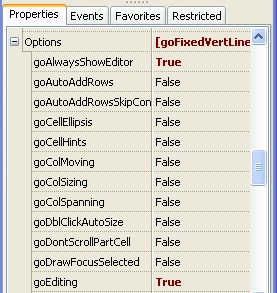
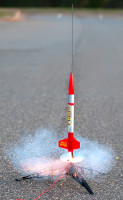
Science makes it known,
Engineering makes it work,
Art makes it beautiful.
Lazarus Sub-form, Grid Cell Background Color, StringGrid Cell Editor, and
Calling FORTRAN
(Includes Downloads)
|
A Lazarus sub-form is a form shown/used/called by a higher
level form using the sub-form's
ShowModal method (calls sub-form's FormShow(...)). The ShowModal method transfers exclusive control to the sub-form. This page looks at part of an actual Lazarus application (MRmain) using sub-forms (both use TStringGrids; one changes the cell background color to red on an error condition, the other uses a simple StringGrid cbsEllipsis Editor Style). One calls procedures in external Librarys.1 untBT10 / FrmBT10 and missle14 / FrmPayload are two sub-forms in a Lazarus multiform application to input and analyze a model rocket design. These two units/forms are used to input/modify/review body tube (or fuselage segment) data for a model rocket. Both use units NumRecGlbl.pas (requires include files genetyp.inc and nrtyp.inc - see Lazarus calling FORTRAN for more information) and MRcommon.pas (requires include file missle.inc, calls procedures in Object Pascal Library missle02.dll) for global data and common procedures. Form Missle10 (see footnote 2 on that page) is another sub-form used by MRmain.
ModalResult:=mrCancel; |
Simplified exploded view of
single stage rocket with conical nose, two body tubes, one conical boattail, and four fins 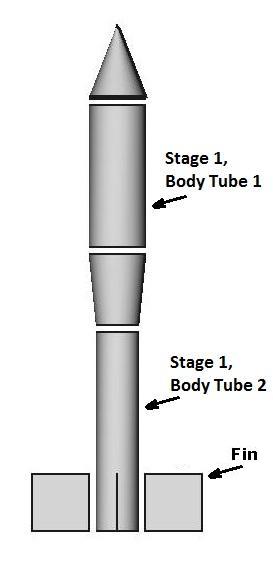
Stage 1, Body Tube 1 can be used as a Payload Section. Couplers (not shown) are used to join nose, body tubes, and conical transitions together. |
For each stage, body tubes are numbered in sequence from stage upper edge or nose tip.
For a consistent User Interface, both sub-forms display body tube sequence, body tube length, and body tube radius in a TStringGrid. Each
TStringGrid row represents a body tube.
Body tube sequence number is temporarily stored in NumRecGlbl variable iData[ ].
Body tube length, body tube radius, body tube mass, body tube cross-sectional area, and body tube surface area are stored in MRcommon
two dimensional arrays (matrices)2; MRcommon variable nbt[ ] is the number of body tubes per stage array.
Cells are right justified using TStringGridPrepareCanvas.
Cells' text are edited using TStringGridSetEditText to allow editing of each cell when entered; recommended method.
Setting ModalResult to a non-zero value closes sub-form; this application uses mrClose to indicate error free close.
|
untBT10 / FrmBT10
Unit untBT10.pas3 contains several procedures that are not members of Class (TFrmBT10); procedure name is not prefixed with class name. These procedures can access instance FrmBT10 variables; however, the variable name must be prefixed with the instance name. See procedure sortBT ( ) below for an example. 'Quick and dirty' demonstration of changing StringGrid Cell background color to Red when an error occurs; a Lazarus Sub-form in an actual application; and calling FORTRAN .dll subprograms via an Object After using the form shown in Lazarus Tabsheets to enter the basic design parameters, When length and diameter for each body tube on all stages have been entered with no errors, body tube cross-sectional and surface area is calculated using procedure By changing the body tube sequence number, it is possible to move body tubes around. If Added three variables to TFrmBT10 public (shown at right): selectedCol (currently edited column), selectedRow (currently edited row), and colorCellRed (true when error occurred, false otherwise). When calls BTsgError (...) (not shown; download source untBT10.pas, link above) to process the error; BTsgError (...) invokes FrmBT10.BTstrngGrid.Repaint; FrmBT10.BTstrngGrid.Repaint triggers colorCellRed = false. When the user selects another stage OR clicks the Sort button OR clicks the Close button, AND stage number of body tubes > 1, sub-form re-sequences the stage body tube matrices with Procedure sortBT ( ) sets boolean variable indxd to true since the index table then for each body tube matrix: moves the current stage body tube matrix column to NumRecGlbl array variable calls nrlazrs Object Pascal procedure moves rData[ ] to current stage body tube matrix column. Close button: closes sub-form and transfers control back to higher level form by setting ModalResult to a non-zero value. Higher level form shows sub-form with: ModalResult:=FrmBT10.ShowModal; Lazarus application glider01 ( |
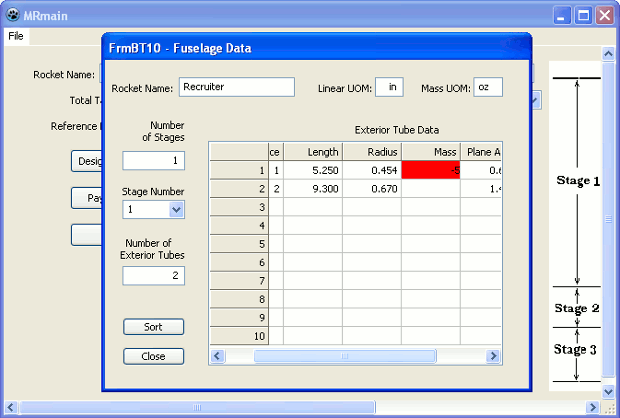
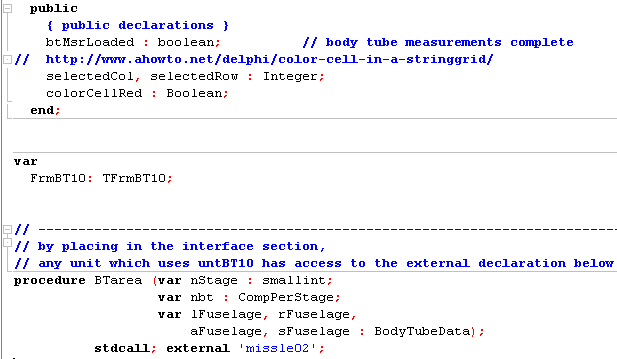
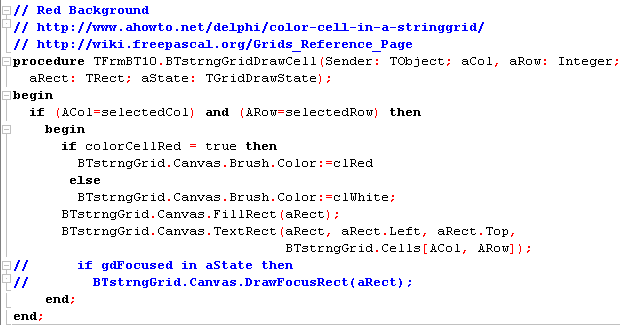

|
|
missle14 / FrmPayload
Unit missle14.pas contains several procedures that are not members of Class (TFrmPayload). A 'quick and dirty' demonstration of using StringGrid cbsEllipsis Editor Style and another example of a Lazarus After using A payload section is used to contain cameras, radio transmitters, scientific instruments or experiments, etc., during flight. StringGrids use cell editors to change the content of cells. Will be using the grid's EditorByStyle method for selecting a body tube for the payload section. The simplest, generic Editor Style to use here is cbsEllipsis, which is a simple button, to be placed in column one ("Select BT") of the sub-form's StringGrid (btStringGrid). Clicking in column one ("Select BT") triggers TFrmPayload.btStringGridSelectEditor(...), causing a button to appear in the editing cell. Clicking on the button invokes TFrmPayload.btStringGridSetEditText(...) cancels any text changes the user may make to btStringGrid. Delete button: Sets Payload Section data to zero. Close button: closes sub-form and transfers control back to higher level form by setting ModalResult to a non-zero value. Higher level form shows sub-form with: ModalResult:=FrmPayload.ShowModal; |
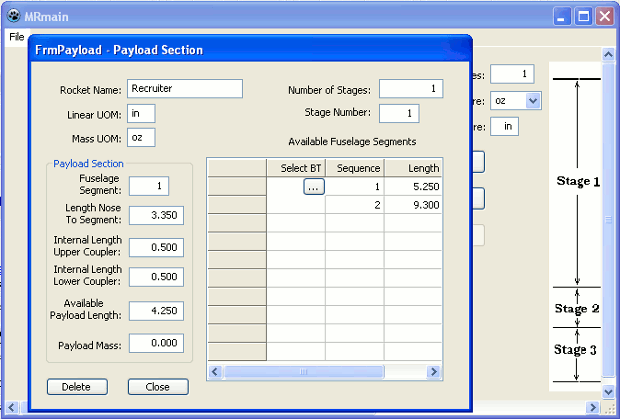
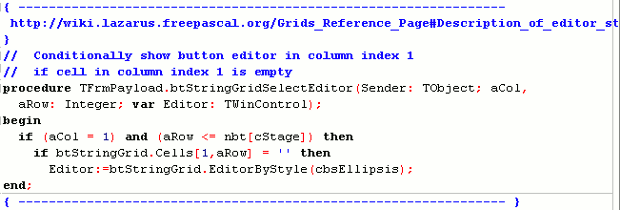
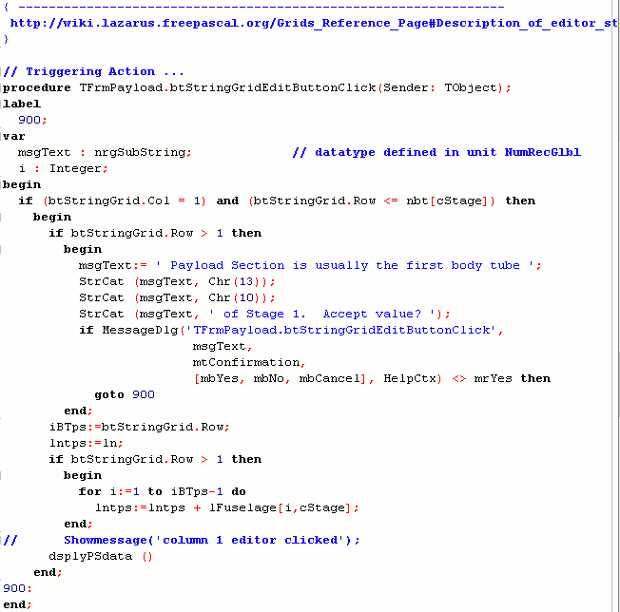
|
1. The projects on this website employs software reuse extensively; this page builds on other pages on this website.
External FORTRAN FUNCTIONS/SUBROUTINES are declared the same way as an Object Pascal external function/procedure, with correct
arguments and return type; refer to Free Pascal Programmer's Guide Chapter 12, Programming shared libraries and
Variable Storage Compatibility and Equivalency.
Have found when a Lazarus program's event procedure directly calls a FORTRAN subprogram, it may produce an Access Violation Exception
when the event procedure exits, even though no calculation errors occurred. This exception does not occur when called via a Free Pascal
Library function/procedure.
2. Each column of the body tube (or fuselage segment) matrices stores the values of all the body tubes being used in the current stage.
3. untBT10 / FrmBT10 is also being used in a Lazarus application to input and analyze Rocket/Glider and other glider designs
(Rocket/Glider and Lifting Body fuselages can be similar to model rockets). The glider modifications require untBT10 uses unit
missle18 and constant ModelRocket. missle18 / FrmFinShpArea is used to input fin/wing/stabilizer measurements and shape for
both model rockets and gliders. Boost/Glider, Rocket/Glider, and Lifting Body specific data are defined in missle18 { public declarations }.
4. Several mathproc.dll subprograms are available for download at tir33.for subprograms.
FORTRAN uses the stdcall calling convention. Unlike Pascal, by default FORTRAN subprograms expects their arguments to be passed
by reference.
5. Had two choices at this point - use proven procedures/SUBROUTINES (would require moving each body tube matrix column to a sort
space, re-sequence the sort space, move sort space back to body tube matrix column) OR develop new procedures/SUBROUTINES
specifically for the body tube matrix datatype (BodyTubeData). Selected the first choice (use proven procedures/SUBROUTINES,
use NumRecGlbl variable rData[ ] for sort space); this method had been used/tested in Missle11 / Missle10 for sorting conical transitions
matrices by Length Nose Tip to Conical Transition; see procedure sortCTstage (...) in unit MRcommon.
6. indxSort (...) calls FORTRAN SUBROUTINEs RSORT3 (...) and SAVECOPY (...) in sttstcs.dll. In this application, RSORT3 (...) is not
used - body tube matrix columns are already indexed by iData[ ].
The Pascal arrays are passed as a fixed size array datatype, most of the FORTRAN subprograms use variable bounds dimensioning.
Fixed size array datatypes defined in include files genetyp.inc, nrtyp.inc, and missle.inc.
|
SAVECOPY (...) external declaration in nrlazrs.pas
RC, IORDER are defined as fixed size array datatypes 
|
SAVECOPY (...) subroutine header in sttstcs.for
R, IORDER are dimensioned with variable bounds - argument N2 is the number of elements 
|
This approach has been successfully used in both D and Free Pascal programs; it may be possible this approach was a contributing factor
to the Lazarus Access Violation Exception mentioned above.
